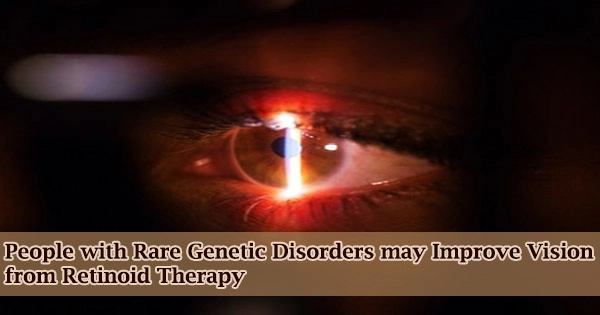Researchers from the University of Maryland School of Medicine (UMSOM), the National Institutes of Health’s National Eye Institute (NEI), and the National Institute on Deafness and Other Communication Disorders (NIDCD) documented the natural history of vision impairment in patients and identified the cell mechanism behind progressive vision loss using data generated from patients and mice with a genetic mutation for the disorder Usher syndrome.
The team was able to test a retinoid medication that improved vision in mice with Usher syndrome based on these findings, which were published in the journal eLife on November 9, 2021. According to the researchers, a similar medication should now be tested in persons with Usher syndrome to see whether it can slow vision loss.
Deafness, gradual visual loss, and balance difficulties are all symptoms of Usher syndrome type 1F (USH1F). There is a 2% probability that each Ashkenazi Jew is a carrier of the Usher syndrome type 1F mutation, which accounts for roughly 60% of their Usher syndrome type 1 cases. In persons with Usher syndrome, there are no approved medicines to prevent or restore visual loss.
“The drug we used in mice may provide a first step to improve eye health in people with Usher syndrome type 1F,” said Zubair M. Ahmed, PhD, Professor of Otorhinolaryngology Head & Neck Surgery and Ophthalmology at UMSOM.
“Unfortunately, these drugs will not permanently cure loss of vision, as the drug does not repair damage or prevent degeneration of the eyes. However, it should improve the function of the tissue that these patients still have.”
First author of the study Saumil Sethna, PhD, Instructor in Otorhinolaryngology Head & Neck Surgery, said, “There are currently FDA-approved relatives of these retinoid drugs that are available and have passed clinical trials for safety, along with others that are in phase II clinical trials to treat other types of vision loss disorders.”
The identification of a key mutation in the PCDH15 gene nearly two decades ago was a critical breakthrough, facilitating the diagnosis of and carrier screening for a certain form of Usher syndrome, now resulting in the discovery of a potential preventative therapy for vision loss associated with the syndrome.
Thomas B. Friedman
The researchers intend to collaborate with one of the businesses studying these medications to begin a clinical trial in individuals with Usher syndrome type 1F to determine if it can help by avoiding further vision loss.
“The identification of a key mutation in the PCDH15 gene nearly two decades ago was a critical breakthrough, facilitating the diagnosis of and carrier screening for a certain form of Usher syndrome, now resulting in the discovery of a potential preventative therapy for vision loss associated with the syndrome,” said Thomas B. Friedman, Ph.D., Chief of the Laboratory of Molecular Genetics at the NIDCD. “This work exemplifies the value of basic science research in driving the development of novel diagnostics and therapeutics.”
Only anecdotal data regarding Usher syndrome type 1F had been reported prior to this study, with no detailed data analysis of the worsening ocular problems with time. Co-authors on this study, including Dr. Friedman of the National Institute of Diabetes and Digestive and Kidney Diseases, started an Usher syndrome natural history project in the early 2000s, enrolling 13 study participants with Usher syndrome 1F to follow the natural progression of their accompanying blindness for 20 or more years.
At the time, Dr. Ahmed was a Postdoctoral Fellow in Dr. Friedman’s group. The natural history study’s lead investigator was Wadih Zein, MD, a NEI ophthalmologist with specialization in inherited retinal degenerations, who reviewed patient findings gathered over the years.
Dr. Zein discovered that the Usher syndrome type 1F mutation caused 50 percent of study participants to be legally blind by the age of 50, based on vision tests.
Dr. Ahmed also developed a mouse with the Usher syndrome, which was discovered in 13 of Dr. Friedman’s patients. The protein protocadherin-15 is truncated as a result of a mutation in the PCDH15 gene.
The mechanism by which this mutant protocadherin-15 caused blindness, however, was unknown. Dr. Friedman’s, Dr. Zein’s, and Dr. Ahmed’s teams agreed to collaborate and analyze the ocular features of humans and mice with this genetic issue that they had acquired independently over the years in order to figure out what was going on.
Dr. Ahmed’s team discovered two functions of protocadherin-15 by comparing the Usher syndrome mouse model to healthy mice. Protocadherin-15, for starters, aids the movement of light-dark cycle proteins between the different compartments of the light-detecting photoreceptors of the eye.
Second, Protocadherin-15 is required for recycling retinoids, which are essential for the proper functioning of eye tissue. In a specific type of eye cell, the Usher syndrome type 1F mutant mice displayed lower quantities of retinoids.
The researchers next gave the Usher disease mice a retinoid medication to test if it improved their vision. The electrical activity in the eyes of both younger and older Usher syndrome mice increased after retinoid injections, indicating enhanced visual function.
“Aside from retinoid replacement, we can also think about developing more permanent therapies to treat or prevent blindness in people with Usher syndrome type 1F that may correct or replace the other functions of protocadherin-15, as well,” said Dr. Ahmed.
E. Albert Reece, MD, Ph.D., MBA, Executive Vice President for Medical Affairs, UM Baltimore, and the John Z. and Akiko K. Bowers Distinguished Professor and Dean, University of Maryland School of Medicine said, “People born with deafness, like individuals with Usher syndrome, rely on their other senses to communicate with and understand the world. Subsequent vision loss can pose significant challenges and can be isolating. This work here builds foundational discoveries that may one day improve the lives of people with rare genetic disorders such as Usher syndrome.”
















